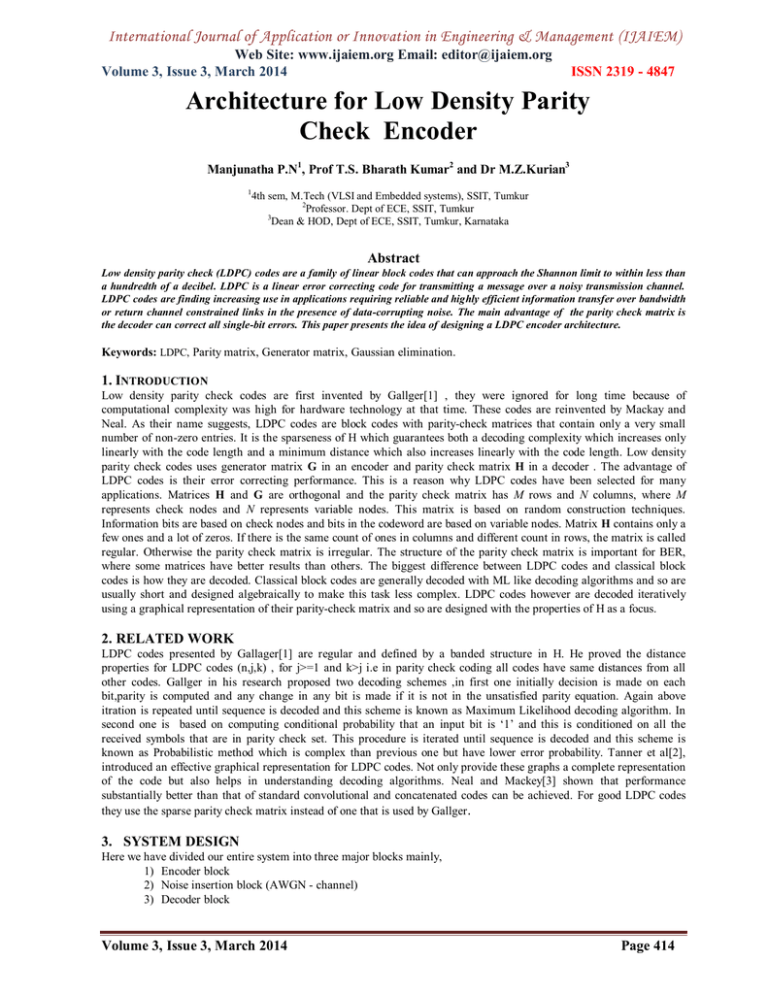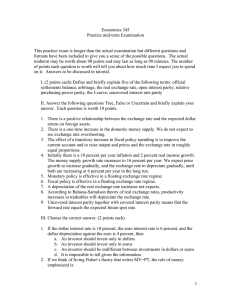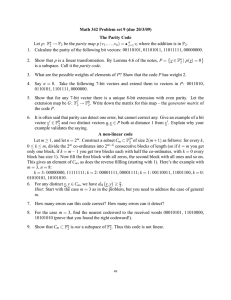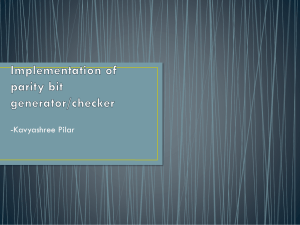International Journal of Application or Innovation in Engineering & Management... Web Site: www.ijaiem.org Email: Volume 3, Issue 3, March 2014
advertisement

International Journal of Application or Innovation in Engineering & Management (IJAIEM)
Web Site: www.ijaiem.org Email: editor@ijaiem.org
Volume 3, Issue 3, March 2014
ISSN 2319 - 4847
Architecture for Low Density Parity
Check Encoder
Manjunatha P.N1, Prof T.S. Bharath Kumar2 and Dr M.Z.Kurian3
1
4th sem, M.Tech (VLSI and Embedded systems), SSIT, Tumkur
2
Professor. Dept of ECE, SSIT, Tumkur
3
Dean & HOD, Dept of ECE, SSIT, Tumkur, Karnataka
Abstract
Low density parity check (LDPC) codes are a family of linear block codes that can approach the Shannon limit to within less than
a hundredth of a decibel. LDPC is a linear error correcting code for transmitting a message over a noisy transmission channel.
LDPC codes are finding increasing use in applications requiring reliable and highly efficient information transfer over bandwidth
or return channel constrained links in the presence of data-corrupting noise. The main advantage of the parity check matrix is
the decoder can correct all single-bit errors. This paper presents the idea of designing a LDPC encoder architecture.
Keywords: LDPC, Parity matrix, Generator matrix, Gaussian elimination.
1. INTRODUCTION
Low density parity check codes are first invented by Gallger[1] , they were ignored for long time because of
computational complexity was high for hardware technology at that time. These codes are reinvented by Mackay and
Neal. As their name suggests, LDPC codes are block codes with parity-check matrices that contain only a very small
number of non-zero entries. It is the sparseness of H which guarantees both a decoding complexity which increases only
linearly with the code length and a minimum distance which also increases linearly with the code length. Low density
parity check codes uses generator matrix G in an encoder and parity check matrix H in a decoder . The advantage of
LDPC codes is their error correcting performance. This is a reason why LDPC codes have been selected for many
applications. Matrices H and G are orthogonal and the parity check matrix has M rows and N columns, where M
represents check nodes and N represents variable nodes. This matrix is based on random construction techniques.
Information bits are based on check nodes and bits in the codeword are based on variable nodes. Matrix H contains only a
few ones and a lot of zeros. If there is the same count of ones in columns and different count in rows, the matrix is called
regular. Otherwise the parity check matrix is irregular. The structure of the parity check matrix is important for BER,
where some matrices have better results than others. The biggest difference between LDPC codes and classical block
codes is how they are decoded. Classical block codes are generally decoded with ML like decoding algorithms and so are
usually short and designed algebraically to make this task less complex. LDPC codes however are decoded iteratively
using a graphical representation of their parity-check matrix and so are designed with the properties of H as a focus.
2. RELATED WORK
LDPC codes presented by Gallager[1] are regular and defined by a banded structure in H. He proved the distance
properties for LDPC codes (n,j,k) , for j>=1 and k>j i.e in parity check coding all codes have same distances from all
other codes. Gallger in his research proposed two decoding schemes ,in first one initially decision is made on each
bit,parity is computed and any change in any bit is made if it is not in the unsatisfied parity equation. Again above
itration is repeated until sequence is decoded and this scheme is known as Maximum Likelihood decoding algorithm. In
second one is based on computing conditional probability that an input bit is ‘1’ and this is conditioned on all the
received symbols that are in parity check set. This procedure is iterated until sequence is decoded and this scheme is
known as Probabilistic method which is complex than previous one but have lower error probability. Tanner et al[2],
introduced an effective graphical representation for LDPC codes. Not only provide these graphs a complete representation
of the code but also helps in understanding decoding algorithms. Neal and Mackey[3] shown that performance
substantially better than that of standard convolutional and concatenated codes can be achieved. For good LDPC codes
they use the sparse parity check matrix instead of one that is used by Gallger.
3. SYSTEM DESIGN
Here we have divided our entire system into three major blocks mainly,
1) Encoder block
2) Noise insertion block (AWGN - channel)
3) Decoder block
Volume 3, Issue 3, March 2014
Page 414
International Journal of Application or Innovation in Engineering & Management (IJAIEM)
Web Site: www.ijaiem.org Email: editor@ijaiem.org
Volume 3, Issue 3, March 2014
ISSN 2319 - 4847
Fig 1: System overview
3.1: LDPC Algorithm
A code word c is generated as
C= kG
where k is the vector of information bits and G is the generator matrix. A valid codeword can be verified using
HCT= 0
Where H is the parity check matrix. If the result in (2) is nonzero, the codeword C is invalid and an error correction
procedure should be used in this case. The Bit flipping method uses a vector, called syndrome , which is computed as
S = HYT,
Where Y is the invalid codeword. The syndrome indicates which row in the H is not zeroed by vector Y and some bits
have to be repaired in the decoder .If the parity check matrix has low size, we can find an error floor of the LDPC code,
where one erroneous bit is repaired and BER is close to zero or is zero.
4. METHODOLOGY
Encoder uses generator matrix to encode the information bits in to the code word. Both generator and parity check matrix
are in inter related, parity check matrix is given by
H=[A | In-k ]
and generator matrix is given by
G=[Ik | AT]
4.1: Encoder Design
Initially parity check matrix is generated, using that generator matrix is created by Gaussian elimination method. There
are two types of parity matrices in LDPC coding one is Regular matrix and another one is irregular matrix. Regular
matrix is one in which column Wc is same for all columns and row weight is given by Wr = Wc(n/m) for all rows. In this
paper we are using regular parity check matrix. Let us consider an 5x10 parity matrix with Wc=2 and Wr=4 as shown in
fig 2,
Fig 2: Regular parity matrix
To transfer the above parity check matrix to standard form i.e H=[A | In-k ] gaussian elimination method is applied.
Gaussian elimination involves elementary row operations which are interchanging two rows or adding one row to another
modulo 2 and also columns. The resulting parity martix in its standard form is as shown in the fig 3,
Fig 3: standard parity matrix
Volume 3, Issue 3, March 2014
Page 415
International Journal of Application or Innovation in Engineering & Management (IJAIEM)
Web Site: www.ijaiem.org Email: editor@ijaiem.org
Volume 3, Issue 3, March 2014
ISSN 2319 - 4847
Obtained parity matrix is translated to standard form generator matrix i.e G=[Ik | AT] as shown in fig 4,
Fig 4 : Generator matrix
Now the information message bits are encoded by multiplying it with above generator matrix i.e C=[U][G] to obtain the
codeword. The below fig 5 shows the encoder block diagram
Fig 5 : Encoder block diagram
Each structure labeled G{0,1,,,m-1},i are XOR structures performs modulo-2 operations on the incoming message bits and the
resultant code words will be of N bits.
Let us consider an 5 bit information message U =[ 1 0 0 1 0 ],
Fig 6: Encoding
By multiplying message bit with generator matrix we obtain the codeword of 10 bits C =[1 0 0 1 0 1 1 1 0 1] . Coding for
this encoder part is done on verilog and encoding is tested for various information bits satisfactorily. Simulation results of
encoder are reported below.
Fig 7: Encoder simulations
Volume 3, Issue 3, March 2014
Page 416
International Journal of Application or Innovation in Engineering & Management (IJAIEM)
Web Site: www.ijaiem.org Email: editor@ijaiem.org
Volume 3, Issue 3, March 2014
ISSN 2319 - 4847
Above figure shows the simulation results obtained from Modelsim 6.3 software. Here initially reset is made high that
output goes low and as reset goes low input is encoded to give codeword . Here input is 10010 and it’s encoded codeword
is 1001011101.
5. CONCLUSION
LDPC is a linear error correcting code for transmitting a message over a noisy transmission channel. LDPC codes are
finding increasing use in applications requiring reliable and highly efficient information transfer over bandwidth or
return channel constrained links in the presence of data corrupting noise . Today, design techniques for LDPC codes exist
which enable the construction of codes which approach the Shannon’s capacity to within hundredths of a decibel. In case
of a single-bit error the bit flipping method will always repair the received codeword, i.e. BER is zero in this case. In this
paper Encoder part design was enhanced and it is designed using Xilinx.
REFERENCES
[1] R. G. Gallager, “Low density parity check codes,” IRE Trans. Inform. Theory, vol. IT-8, no.1, pp. 21–28, Jan. 1962
[2] D. J. C. MacKey, R. M. Neal, “Near Shannon limit performance of low density parity check codes,” Electronics
letters, vol. 32, no.18, pp.1645–1646.
[3] R. M. Tanner, “A Recursive Approach to Low Complexity Codes,” IEEE Trans. Inform. Theory, vol. IT-27, no.5,
pp. 533–547, Sep. 1981.
[4] S. J. Johnson, “Introducing Low-Density Parity-Check Codes,” unpublished.
[5] T. Richardson, “Error floors of LDPC codes,” in Proc. Annual Allerton Conference on Communication, Control, and
Computing, Monticello, IL, pp. 1426-1435, Oct. 2003.
[6] T. Tian, C. Jones, J. Villasenor, and R. D. Wesel, “Construction of irregular ldpc codes with low error floors,” in
Proceedings IEEE International Conference on Communications, 2003.
[7] An FPGA Architecture for Low Density Parity Check Codes ,Orlando J. Hernandez and Nathaniel F. Blythe.
Volume 3, Issue 3, March 2014
Page 417






